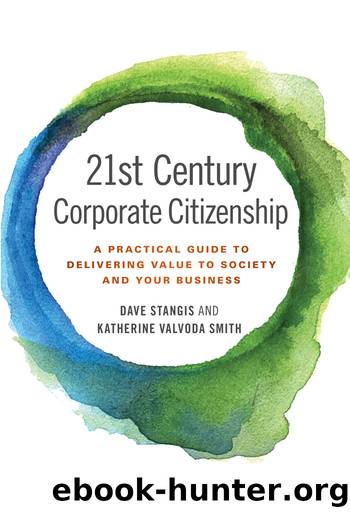21st Century Corporate Citizenship by Stangis Dave; Smith Katherine Valvoda;

Author:Stangis, Dave; Smith, Katherine Valvoda;
Language: eng
Format: epub
Publisher: Emerald Publishing Limited
Published: 2017-03-07T16:00:00+00:00
THE RIGHT METRICS AND INCENTIVES
The people you’ve organized to implement your processes are more likely to stay engaged with your initiative if it’s clear to them how you will measure and reward success. Establishing agreed upon metrics is vital in that they communicate progress, so everyone can understand what’s been achieved. There’s nothing more demotivating than working hard on a project only to be left in the dark about what the end results have been, or even how it’s progressing as time goes by.
Incentives for performance are, of course, a little tricky when you’re managing people through influence (rather than by direct control) as you can’t necessarily give them financial rewards. There are other incentives you can offer, however. One is a job well done; intrinsic motivations like satisfaction can be a powerful incentive to continue, and people like to carry on doing things they experience success with. Public recognition for achieving milestones can also be a powerful motivator, especially when it’s conferred by your CEO or other key players in your c-suite.
Different employee groups are motivated by different things. If an early career employee who’s very interested in developing their professional network is publicly praised for their contribution to a corporate citizenship project, and as a result, it comes to the attention of a top level executive, they can perceive that as more of a benefit than being recognized by their direct manager. For a more experienced employee, the reward would be more likely to come from getting involved in something bigger than themselves, which allows them to leave the world (and the company) a better place. It’s part of their legacy.
This is good news for you, because you’re unlikely to have a budget to reward people financially, but you can reward them in other ways. As part of its reward structure, Campbell has put in place an array of employee recognition programs for work related to sustainability and social responsibility. These have included peer recognition programs, and handwritten notes from the CEO, along with praise at employee forums and in articles on the company’s intranet. There are also social responsibility components included in Campbell’s Greatness Awards, which are their highest recognition for work done by individuals and teams. The CEO and corporate leadership present these awards annually.
As you get more sophisticated and your program matures, you can think about pay incentives. Among managers and executives, compensation is a growing part of the reward structure.1
Download
This site does not store any files on its server. We only index and link to content provided by other sites. Please contact the content providers to delete copyright contents if any and email us, we'll remove relevant links or contents immediately.
What's Done in Darkness by Kayla Perrin(25499)
Shot Through the Heart: DI Grace Fisher 2 by Isabelle Grey(18218)
Shot Through the Heart by Mercy Celeste(18160)
The Fifty Shades Trilogy & Grey by E L James(17774)
The 3rd Cycle of the Betrayed Series Collection: Extremely Controversial Historical Thrillers (Betrayed Series Boxed set) by McCray Carolyn(13189)
The Subtle Art of Not Giving a F*ck by Mark Manson(12910)
Scorched Earth by Nick Kyme(11831)
Stepbrother Stories 2 - 21 Taboo Story Collection (Brother Sister Stepbrother Stepsister Taboo Pseudo Incest Family Virgin Creampie Pregnant Forced Pregnancy Breeding) by Roxi Harding(11040)
Drei Generationen auf dem Jakobsweg by Stein Pia(10216)
Suna by Ziefle Pia(10185)
Scythe by Neal Shusterman(9259)
International Relations from the Global South; Worlds of Difference; First Edition by Arlene B. Tickner & Karen Smith(8608)
Successful Proposal Strategies for Small Businesses: Using Knowledge Management ot Win Govenment, Private Sector, and International Contracts 3rd Edition by Robert Frey(8419)
This is Going to Hurt by Adam Kay(7693)
Dirty Filthy Fix: A Fixed Trilogy Novella by Laurelin Paige(6453)
He Loves Me...KNOT by RC Boldt(5804)
How to Make Love to a Negro Without Getting Tired by Dany LaFerrière(5378)
Interdimensional Brothel by F4U(5304)
Thankful For Her by Alexa Riley(5161)
